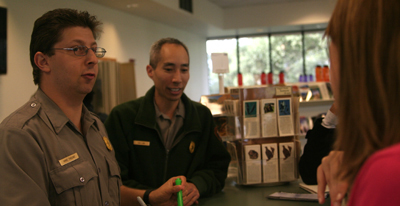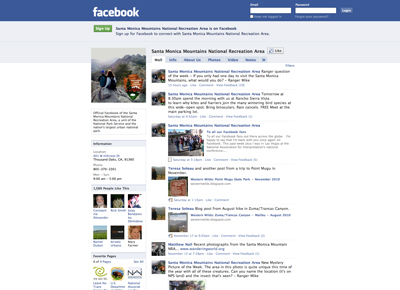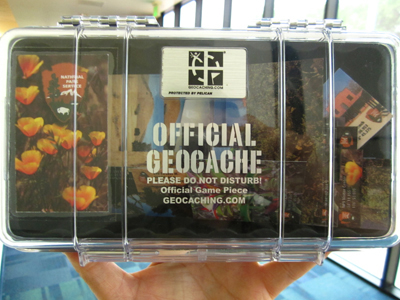
Park uses social networking to reach visitors
THOUSAND OAKS, Calif. — Though the U.S. National Park Service (NPS) remains relatively old fashioned when it comes to social media, it has gradually become more open to the technology.
Interpretative Ranger Mike Theune of the Santa Monica Mountains recalls not being able to use Adobe Flash until the summer of 2009. In fact, when he came on as an intern two years prior, there was no access to Twitter and Facebook at the recreation area.
Theune’s job as Webmaster consists of more than just sitting in front of the computer 75 percent of the time. When he’s at various locations in the mountains, he takes full advantage of social networking by live tweeting photos or statuses.
It’s hardly the job description one usually considers for a park ranger.
“We’re trying new things even though the National Park Service is steeped in tradition,” Theune said. “There are old school ranger-led programs out there, but we’ve still got to keep up with the times.”
Interpretative Ranger Ken Low admires what Theune has been able to do since the previous Webmaster left for another park.
When Theune initially came to the Santa Monica Mountains in 2007 as an intern, he hoped that rangers could have some form of interaction with visitors outside the confines of the park.
This is where he came up with the idea of creating Facebook and Twitter accounts.
“It’s good to get someone young and interested and knows all the stuff because a lot of us have been here for so long that we’re not up with the times,” Low said of the 26-year-old. “It’s always good to get new and young blood to try out new things on us.”
| Santa Monica Mountains NRA Interpretive Rangers Mike Theune, left, and Ken Low give directions to a visitor at the Visitor Center in Thousand Oaks, Calif. (Photo by Christina De Nicola). |  |
Now, a year after their launches, Theune is largely responsible for the content posted on both sites.
He insists the best part about using these social media tools is the real-time information. For example, if there’s a fire, an alert can be sent out right away to the 2,072 Twitter followers.
Initially, visitors started posting pictures asking what a certain plant, animal or object was. This helped form an identity for the Facebook page. The most popular update relates to the “Mystery Picture of the Week.”
Teresa Soleau, 27, is a recent graduate of an information studies master’s program at UCLA.
She has hiked in the mountains four times this year and has lived in Los Angeles the past five years. She found the Facebook page by searching for it.
As Theune explained, Soleau uses it to ask about something she finds on a hike.
“It’s great to post a photo of something you saw and have someone identify it for you,” Soleau wrote in a Facebook message. “Nature is so strange sometimes!”
Last month, Shawn Card, 38, visited the mountains and posted a few photos asking what type of paw print was on the ground. He later found out, thanks to Theune, that it was a bobcat print.
Card, who moved to Los Angeles in 2003 as a videographer, found the Facebook page when he envisioned taking advantage of what the city had to offer. He tries to go to the park once a month and stays between one to four hours, depending on the hike.
What Card appreciates most about the new shift toward social networking are the notifications about events taking place.
He never would’ve known about the 10th annual Cider at Circle X Ranch otherwise. There was free apple cider, cookies, candy and coffee.
“It’s an easy way to find out what’s going on. It lets people become more involved and feel connected to the parks,” Card wrote. “It’s just a good way to keep people interested and have them keep coming back.
According to Theune, the main draw to social networking is the ability to reach an audience that can’t visit the actual site, but still wants an educational experience.
“The idea’s that parks aren’t just for people who are there, but everybody,” Theune said. “We want to encourage awareness of it around the world since we’re a Mediterranean climate and that’s present in only two percent of the world.”
Freelance photographer Matthew Nall, 26, has been visiting the Santa Monica Mountains for most of his life and lives about 20 minutes away.
As an avid climber and hiker, he enjoys the ability to explore on his own and connect with nature. He doesn’t necessarily agree with the push toward social networking within the parks.
“I’m a big supporter of conservation efforts and limiting access,” he said. “I’m not so much as an activist as I try not to participate so much in telling people where things are and spreading the word.”
He sees Twitter and Facebook more as an entertainment aspect for those who wouldn’t necessarily seek the information out on their own.
Despite this, he is one of the 1,588 people who like the recreation area on Facebook. Earlier this month, he posted a link to his blog, wanderingworld.org, with photos he took.
“When I go to these different places, a lot of my time revolves around travel and climbing and hiking, nature-oriented activities,” Nall said.
The Santa Monica Mountains aren’t alone in their pursuit of social networking. Golden Gate National Recreation Area and its Alcatraz Island is one of the leaders in the movement, with 1,238 Twitter followers.
Interpretative Ranger Craig Glassner helped spearhead the campaign ever since the 2006 announcement of Twitter in the San Francisco area.
| A Web screen capture of the Santa Monica Mountains NRA on Facebook (Screen capture by Christina De Nicola). |  |
Every day, Glassner, who has been working at the park for 19 years, writes information on a board in the visitor center about the Twitter, Facebook and Web pages.
Of the 671 tweets posted on the feed, most come “live” from the field, mentioning anything from a parking lot being closed to a beach being full.
Glassner has notifications sent to his phone so that he may answer any questions in a timely manner.
Specifically for Alcatraz, Glassner uses Twitter to inform people about buying their Alcatraz Cruise tickets in advance. In order to visit the island, a visitor must take a boat to the former prison. During the summer and holidays, tickets sell out quickly.
“We’ve done that with some success because only a small percentage of people are using that,” Glassner said.
Like the Santa Monica Mountains, Twitter and Facebook are also used as educational tools to provide facts about the island.
On Thanksgiving, for example, the island hosted the Indigenous People’s Sunrise Gathering, which is a commemoration of the 1969-71 occupation of Alcatraz by the “Indians of All Tribes.”
Glassner posted photos from the event and had also alerted visitors beforehand that the park would not have regular tours offered that day.
Although social networking has been around for years, there’s still disconnect between Glassner and his coworkers who don’t understand the technology.
“I liken it to the early days of the Internet,” Glassner said. “When we first started talking about the Internet to management, they asked, ‘Who would want to get information from the Internet?’ Clearly, people do and are.”
But for Theune and the Santa Monica Mountains, it doesn’t stop at social networking. He is working on revolutionizing how visitors experience a park via geocaching, or GPS-based recreational activities.
 |
Post cards in this geocache box highlight six locations within the park. The goal is for visitors to collect all six to solve the search puzzle in this recreational and educational activity (Photo courtesy of Santa Monica Mountains NRA). |
According to Theune, picture a virtual treasure hunt where an object is usually left behind. Visitors will get a set of coordinates, go to various sites and pick up an object that will educate them on the recreation area.
“ParkCaching,” as Theune is calling it, can be considered a “glorified brochure with a GPS coordinate to it.”
At the Santa Monica Mountains, there will be six locations: Solstice Canyon, Circle X Ranch, Paramount Ranch, NPS Visitor Center, Cheeseboro Canyon and Rancho Sierra Vista/Satwiwa.
Coordinates can track each location on a GPS system. A postcard may be found at each site. On the front of the card is an image of the location and on the back educational information.
The goal is to collect all six and solve a puzzle that creates an iconic image from the Santa Monica Mountains.
“It’s a way to do interpretive programming without having any impact on the resource,” Theune said. “You’d never know it was there unless you had a GPS and the coordinates.”
The initial concept came to Theune when school groups wanted to take something with them as a memento from what they had learned.
“It’s one of the coolest things, I have to say, that we’ve developed for some time,” he said. “You get to put the puzzle pieces together.”
While Theune focuses on the upside of ParkCaching, Alcatraz has been utilizing Foursquare. This technology allows people to link to different locations via their cell phones.
“Our hope is that people will check in on Alcatraz and see that it’s part of a tour and may be exposed to visit other parks on the island that they might not have otherwise visited,” Glassner said.
And now, there’s an NPS-wide policy in the final draft stage that would standardize what is and isn’t allowed by the parks in terms of social networking. It should be ready to launch by the New Year.
But why has there been hesitation from the parks service until this point?
The main reason the federal government has restricted the evolution stems from security issues. The NPS Web site is one of the most frequently attacked pages because people think they can change it. Hackers believe it won’t be as secure as the FBI or CIA.
Every year the Web site receives half a billion hits. The Santa Monica Mountains reach just under 700,000 for a park not as popular as Yellowstone or Yosemite.
What does this mean for the future of the National Park Service?
Glassner believes it’s “just around the corner” when any type of camera — be it video, still or from a phone — takes a photo, and through the Internet, identifies immediately where it was taken, where the person is and what else is around the area.
“Instead of being reactive we’re being really proactive,” Theune said.
If You Go
What: Santa Monica Mountains National Recreational Area.
Twitter: @SantaMonicaMtns.
Facebook: http://www.facebook.com/santamonicamtns
Web site: http://www.nps.gov/samo.

Comments are Closed